A Study on the Effects of Vertical Mass Irregularity on Seismic Behavior of BRBFs and CBFs
Abstract
:1. Introduction
1.1. Literature Review
1.2. Objective of the Study
2. Buildings Studied
2.1. Design of the Buildings
2.2. Simulated Frames in OpenSees
2.3. Nonlinear Analysis of the Frames
3. Ground Motions
4. Seismic Performance
4.1. Drift
4.2. Displacement
4.3. Base Shear
4.4. Acceleration
5. Conclusions
- Based on the results of the nonlinear time history analyses, regardless of the regularity status of the frames, the mean drift is lower in the CBFs than BRBFs. In other words, the CBFs improve the drift performance in comparison with the BRBFs. Compared to using CBFs, employing the BRBFs increase the mean drift by 47% and 77% in the irregular 10-story and 15-story frames, respectively. Furthermore, the maximum drift is higher in the frames with BRBs than in those with CBFs irrespective of their number of floors and regularity. With the largest magnitude among the 12 selected records, Duzce earthquake (Kocaeli, Turkey) also imposes the highest drift on all the eight studied frames.
- In contrast to the 10-story frames, using the BRB increase the base shear as a design parameter in both the regular and irregular 15-story frames. Moreover, the maximum base shear is observed in the 10-and 15-story MIR-BRBF.
- Negligible differences are ultimately observed in the mean value of the maximum floor acceleration between the four regular and irregular 10-story frames with either CBFs or BRBs. In contrast, the mean value of the maximum acceleration is higher in the 15-story frames with BRBs than in those with CBFs.
- An earthquake with the highest PGA among all the selected records imposes the highest acceleration on the top floors of all the eight frames. The maximum acceleration is also reported in the 10- and 15-story MIR-BRBFs.
- The maximum displacement of the top floor is higher in the frames with BRBs than in those with CBFs.
Author Contributions
Funding
Conflicts of Interest
References
- Takeuchi, T.; Wada, A. Review of Buckling-Restrained Brace Design and Application to Tall Buildings. Int. J. High-Rise Build. 2018, 7, 187–195. [Google Scholar] [CrossRef]
- Takeuchi, T.; Wada, A. Buckling-Restrained Braces and Applications; JSSI: Tokyo, Japan, 2017. [Google Scholar]
- Kim, D.H.; Lee, C.H.; Ju, Y.K.; Kim, S.D. Sub assemblage test of buckling-restrained braces with H-shaped steel core. Struct. Des. Tall Spec. Build. 2015, 24, 243–256. [Google Scholar] [CrossRef]
- Lai, M.H.; Chen, M.T.; Ren, F.M.; Ho, J.C.M. Uni-axial behavior of externally confined UHSCFST columns. Thin Walled Struct. 2019, 142, 19–36. [Google Scholar] [CrossRef]
- Kioumarsi, B.; Kheyroddin, A.; Gholhaki, M.; Kioumarsi, M.; Hooshmandi, S. Effect of span length on behavior of MRF accompanied with CBF and MBF systems. Procedia Eng. 2017, 171, 1332–1340. [Google Scholar] [CrossRef]
- Bypour, M.; Gholhaki, M.; Kioumarsi, M.; Kioumarsi, B. Nonlinear analysis to investigate effect of connection type on behavior of steel plate shear wall in RC frame. Eng. Struct. 2019, 179, 611–624. [Google Scholar] [CrossRef]
- Kioumarsi, B.; Gholhaki, M.; Kheyroddin, A.; Kioumarsi, M. Analytical study of building height effects over Steel Plate Shear Wall Behavior. Int. J. Eng. Technol. Innov. 2016, 6, 255–263. [Google Scholar]
- Bypour, M.; Kioumarsi, M.; Yekrangnia, M. Shear capacity prediction of stiffened steel plate shear walls (SSPSW) with openings using response surface method. Eng. Struct. 2021, 226, 111340. [Google Scholar] [CrossRef]
- Bypour, M.; Kioumarsi, B.; Kioumarsi, M. Investigation of Failure Mechanism of Thin Steel Plate Shear Wall in RC Frame. Key Eng. Mater. 2019, 803, 314–321. [Google Scholar] [CrossRef]
- Vafaei, D.; Eskandari, R. Seismic response of mega buckling-restrained braces subjected to fling-step and forward-directivity near-fault ground motions. Struct Des. Tall Spec. Build. 2015, 24, 672–686. [Google Scholar] [CrossRef]
- Liu, X.; Zhou, X.; Zhang, A.; Tian, C.; Zhang, X.; Tan, Y. Design and compilation of specifications for a modular-prefabricated high-rise steel frame structure with diagonal braces. Part I: Integral structural design. Struct. Des. Tall Spec. Build. 2018, 27, e1415. [Google Scholar] [CrossRef]
- Nazarimofrad, E.; Shokrgozar, A. Seismic performance of steel braced frames with self-centering buckling-restrained brace utilizing super elastic shape memory alloys. Struct. Des. Tall Spec. Build. 2019, 28, e1666. [Google Scholar] [CrossRef]
- Chou, C.C.; Hsiao, C.H.; Chen, Z.B.; Chung, P.T.; Pham, D.H. Seismic loading tests of full-scale two-story steel building frames with self-centering braces and buckling-restrained braces. Thin-Walled Struct. 2019, 140, 168–181. [Google Scholar] [CrossRef]
- Lin, P.; Takeuchi, T.; Matsui, R. Seismic performance evaluation of single damped outrigger system incorporating buckling-restrained braces. Earthq. Eng. Struct. Dyn. 2018, 47, 2343–2365. [Google Scholar] [CrossRef] [Green Version]
- Xing, L.; Zhou, Y. Optimization analysis of ordinary outrigger trusses and outrigger trusses with buckling restrained braces. J. Build. Struct. 2018, 36, 1–10. (In Chinese) [Google Scholar] [CrossRef] [Green Version]
- Beiraghi, H. Near-fault ground motion effects on the responses of tall reinforced concrete walls with buckling-restrained brace outriggers. Sci. Iran. 2018, 25, 1987–1999. [Google Scholar] [CrossRef] [Green Version]
- Deng, K.; Pan, P.; Lam, A.; Xue, Y. A simplified model for analysis of high-rise buildings equipped with hysteresis damped outriggers. Struct. Des. Tall Spec. Build. 2014, 23, 1158–1170. [Google Scholar] [CrossRef]
- Lin, P.C.; Takeuchi, T.; Matsui, R. Optimal design of multiple damped-outrigger system incorporating buckling-restrained braces. Eng. Struct. 2019, 194, 441–457. [Google Scholar] [CrossRef]
- Asai, T.; Chang, C.M.; Phillips, B.M.; Spencer, B.F., Jr. Real-time hybrid simulation of a smart outrigger damping system for high-rise buildings. Eng. Struct. 2013, 57, 177–188. [Google Scholar] [CrossRef]
- Xinga, L.; Zhoua, Y.; Huang, W. Seismic optimization analysis of high-rise buildings with a buckling restrained brace outrigger system. Eng. Struct. 2020, 220, 110959. [Google Scholar] [CrossRef]
- Zhou, Y.; Zhang, C.Q.; Lu, X.L. Seismic performance of a damping outrigger system for tall buildings. Struct. Control Health Monit. 2017, 24, e1864. [Google Scholar] [CrossRef]
- Darshan, D.; Shruthi, H.K. Study on Mas Irregularity of High-Rise Buildings. Int. Res. J. Eng. Technol. (Irjet) 2016, 3, 1123–1131. [Google Scholar]
- Standard 2800. Iranian Code of Practice for Seismic Resistant Design of Buildings, 4th ed.; Building and Housing Research Center: Tehran, Iran, 2014. [Google Scholar]
- Pirizadeh, M.; Shakib, H. Probabilistic seismic performance evaluation of non-geometric vertically irregular steel buildings. J. Constr. Steel Res. 2013, 82, 88–98. [Google Scholar] [CrossRef]
- Shakib, H.; Nodeh, M.; Homaei, F. Fragility Curve Development for Assessing Midrise Steel Building with Buckling Resistant Braced System Having Vertical Irregularity. JSEE 2015, 17, 293–304. [Google Scholar]
- Amiri, M.; Yakhchalian, M. Performance of intensity measures for seismic collapse assessment of structures with vertical mass irregularity. Structures 2020, 24, 728–741. [Google Scholar] [CrossRef]
- Naveen, E.S.; Abraham, N.M.; Kumari, D.A. Parametric Studies on the Seismic Behavior of Irregular Structures. Struct. Integr. Assess. 2019, 48, 839–850. [Google Scholar] [CrossRef]
- Angelos, S.T.; Konstantinos, A.S.; Beskos, D.E. A Hybrid Seismic Design Method for Steel Irregular Space Moment Resisting Frames. J. Earthq. Eng. 2020, 1–36. [Google Scholar] [CrossRef]
- Köber, D. Seismic Design Particularities of a Five Story Reinforced Concrete Structure, Irregular in Plan and Elevation. In Seismic Behaviour and Design of Irregular and Complex Civil Structures III; Springer: Cham, Switzerland, 2020; pp. 189–199. [Google Scholar] [CrossRef]
- Yassin, A. Seismic Performance Evaluation of Stiffness Irregular RC Buildings due to Story Height Difference. Master’s Thesis, Science in Civil Engineering, Addis Ababa Science and Technology University, Addis Ababa, Ethiopia, October 2019. [Google Scholar]
- Ngamkhanong, C.; Kaewunruen, S.; Baniotopoulos, C. Far-Field Earthquake Responses of Overhead Line Equipment (OHLE) Structure Considering Soil-Structure Interaction. Front. Built Environ. 2018, 4, 35. [Google Scholar] [CrossRef]
- Chen, R.; Qiu, C.; Hao, D. Seismic Response Analysis of Multi-Story Steel Frames Using BRB and SCB Hybrid Bracing System. Appl. Sci. 2020, 10, 284. [Google Scholar] [CrossRef] [Green Version]
- Shen, J.; Seker, O.; Akbas, B.; Seker, P.; Momenzadeh, S.; Faytarouni, M. Seismic performance of concentrically braced frames with and without brace buckling. Eng. Struct. 2017, 141, 461–481. [Google Scholar] [CrossRef]
- Hsiao, P.C.; Lehman, D.E.; Roeder, C.W. Improved analytical model for special concentrically braced frames. J. Constr. Steel Res. 2012, 73, 80–94. [Google Scholar] [CrossRef]
- Hoveidae, N.; Rafezy, B. Overall buckling behavior of all-steel buckling restrained braces. J. Constr. Steel Res. 2012, 79, 151–158. [Google Scholar] [CrossRef]
- Hosseinzadeh, S.H.; Mohebi, B. Seismic evaluation of all-steel buckling restrained braces using finite element analysis. J. Constr. Steel Res. 2016, 119, 76–84. [Google Scholar] [CrossRef]
- Zhu, B.L.; Guo, Y.L.; Zhou, P.; Bradford, M.A.; Pi, Y.L. Numerical and experimental studies of corrugated-web-connected buckling-restrained braces. Eng. Struct. 2017, 134, 107–124. [Google Scholar] [CrossRef]
- Ebadi Jamkhaneh, M.; Kafi, M.A. Equalizing octagonal PEC columns with steel columns: Experimental and theoretical study. Pract. Period. Struct. Des. Constr. 2018, 23, 04018012. [Google Scholar] [CrossRef]
- Ebadi Jamkhaneh, M.; Kafi, M.A. Experimental and numerical study of octagonal composite column subject to various loading. Period. Polytech. Civ. Eng. 2018, 62, 413–422. [Google Scholar] [CrossRef] [Green Version]
- Ahadi Koloo, F.; Badakhshan, A.; Fallahnejad, H.; Ebadi Jamkhaneh, M.; Ahmadi, M. Investigation of proposed concrete filled steel tube connections under reversed cyclic loading. Int. J. Steel Struct. 2018, 18, 163–177. [Google Scholar] [CrossRef]
- Ebadi Jamkhaneh, M.; Homaioon Ebrahimi, A.; Shokri Amiri, M. Investigation of the Seismic Behavior of Brace Frames with New Corrugated All-Steel Buckling Restrained Brace. Int. J. Steel Struct. 2019, 19, 1225–1236. [Google Scholar] [CrossRef]
- Karavasilis, T.L.; Bazeos, N.; Beskos, D.E. Estimation of seismic inelastic deformation demands in plane steel MRF with vertical mass irregularities. Eng. Struct. 2008, 30, 3265–3275. [Google Scholar] [CrossRef]
- Valmundsson, E.V.; Nau, J.M. Seismic response of building frames with vertical structural irregularities. J. Struct. Eng. 1997, 123, 30–41. [Google Scholar] [CrossRef]
- Choi, B.J. Hysteretic energy response of steel moment-resisting frames with vertical mass irregularities. Struct. Des. Tall Spec. Build. 2004, 13, 123–144. [Google Scholar] [CrossRef]
- ASCE/SEI 7-16. Minimum Design Loads for Buildings and other Structures; SEI: Reston, VA, USA, 2017. [Google Scholar]
- Davoodi, M.; Sadjadi, M. Assessment of near-field and far-field strong ground motion effects on soil-structure SDOF system. IJCE 2015, 13, 153–166. [Google Scholar] [CrossRef]
- Ngamkhanong, C.; Pinkaew, T. Effectiveness of tuned mass damper in damage reduction of building under far-field ground motions. In Proceedings of the 5th ECCOMAS Thematic Conference on Computational Methods in Structural Dynamics and Earthquake Engineering (Crete), Crete Island, Greece, 25–27 May 2015; pp. 972–983. [Google Scholar] [CrossRef]
- Ansari, M.; Safiey, A. Evaluation of seismic performance of mid-rise reinforced concrete frames subjected to far-field and near field ground motions. Earthq. Struct. Struct. 2018, 5, 453–462. [Google Scholar] [CrossRef]
- Mortezaei, A.; Ronagh, H.R. Plastic hinge length of reinforced concrete columns subjected to both far fault and near fault ground motions having forward directivity. Struct. Des. Tall Spec. Build. 2013, 22, 903–926. [Google Scholar] [CrossRef]
- Cao, V.V.; Ronagh, H.R. Correlation between seismic parameters of far-fault motions and damage indices of low-rise reinforced concrete frames. Soil Dyn. Earthq. Eng. 2014, 66, 102–112. [Google Scholar] [CrossRef]
- Zhang, S.; Wang, G. Effects of near-fault and far-fault ground motions on nonlinear dynamic response and seismic damage of concrete gravity dams. Soil Dyn. Earthq. Eng. 2013, 53, 217–229. [Google Scholar] [CrossRef]
- Belejo, A.; Bento, R. Improved modal pushover analysis in seismic assessment of asymmetric plan buildings under the influence of one and two horizontal components of ground motions. Soil Dyn. Earthq. Eng. 2016, 87, 1–15. [Google Scholar] [CrossRef]
- Balic, I.; Trogrlic, B.; Mihanovic, A. Simplified multimodal pushover target acceleration method for seismic resistance analysis of medium-rise RC structures. KSCE J. Civ. Eng. 2017, 21, 378–388. [Google Scholar] [CrossRef]
- Li, S.; Zuo, Z.; Zhai, C.; Xie, L. Comparison of static pushover and dynamic analyses using RC building shaking table experiment. Eng. Struct. 2017, 136, 430–440. [Google Scholar] [CrossRef]
- Shahbazi, S.H.; Karami, A.; Mansouri, I.; Hu, J.W. Seismic response of steel moment frames (SMFs) considering simultaneous excitations of vertical and horizontal components, including fling-step ground motions. Appl. Sci. 2019, 9, 2079. [Google Scholar] [CrossRef] [Green Version]
- Shahbazi, S.H.; Mansouri, I.; Hu, J.W.; Sam Daliri, N.; Karami, A. Seismic response of steel SMFs subjected to vertical components of far-and near-field earthquakes with forward directivity effects. Adv. Civ. Eng. 2019. [Google Scholar] [CrossRef]
- Mansouri, I.; Shahbazi, S.; Nejat, M.; Karami, A. Effect of Soil Classification on Seismic Behavior of SMFs considering Soil-Structure Interaction and Near-Field Earthquakes. Shock Vib. 2018. [Google Scholar] [CrossRef] [Green Version]
- Shahbazi, S.; Khatibinia, M.; Mansouri, I.; Hu, J.W. Seismic evaluation of special steel moment frames undergoing near-field earthquakes with forward directivity by considering soil-structure interaction effects. Sci. Iran. 2018. [Google Scholar] [CrossRef] [Green Version]
- Mansouri, I.; Shahbazi, S.; Hu, J.W.; Moghaddam, S.A. Effects of pulse-like nature of forward directivity ground motions on the seismic behavior of steel moment frames. Earthq. Struct. 2019, 17, 1–15. [Google Scholar] [CrossRef]
- HAZUS-MH MR5: Multi-Hazard Loss Estimation Methodology: Earthquake Model. In Federal Emergency Management Agency; U.S. Department of Homeland Security: Washington, DC, USA, 2011.
- ACI Committee 318. Building Code Requirements for Structural Concrete (ACI 318-05) and Commentary (ACI 318R-05); American Concrete Institute: Farmington Hills, MI, USA, 2005. [Google Scholar]
- Shaik, I.; Anwar, S.F.; Hashmath, M. Response Spectrum and Time History Analysis of a Multistoried and Commercial Building. Glob. J. Eng. Sci. Res. 2017, 4. [Google Scholar] [CrossRef]
- Mazzoni, S.; McKenna, F.; Scott, M.H.; Fenves, G.L. OpenSees Command Language Manual; University of California: Berkeley, CA, USA, 2006; Available online: http://opensees.berkeley.edu/manuals/usermanual (accessed on 19 July 2006).
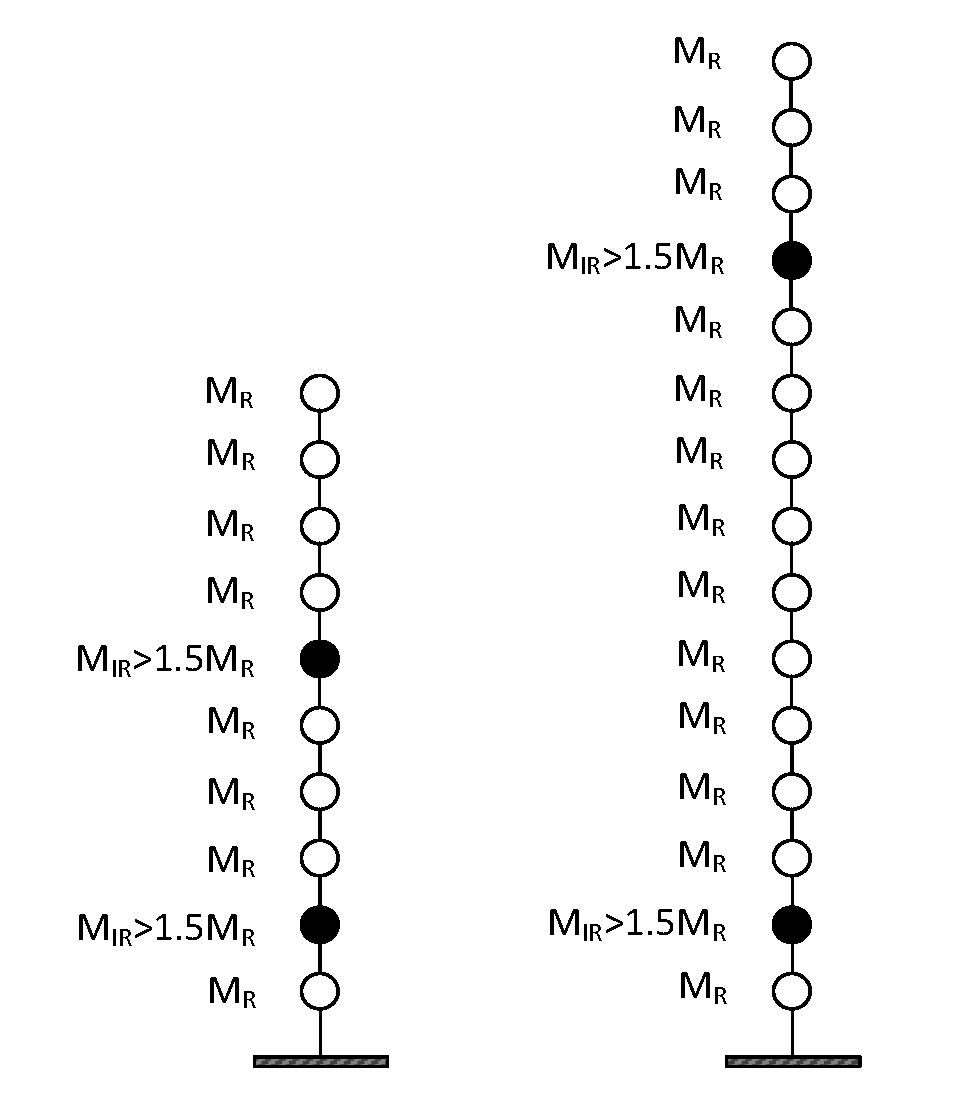
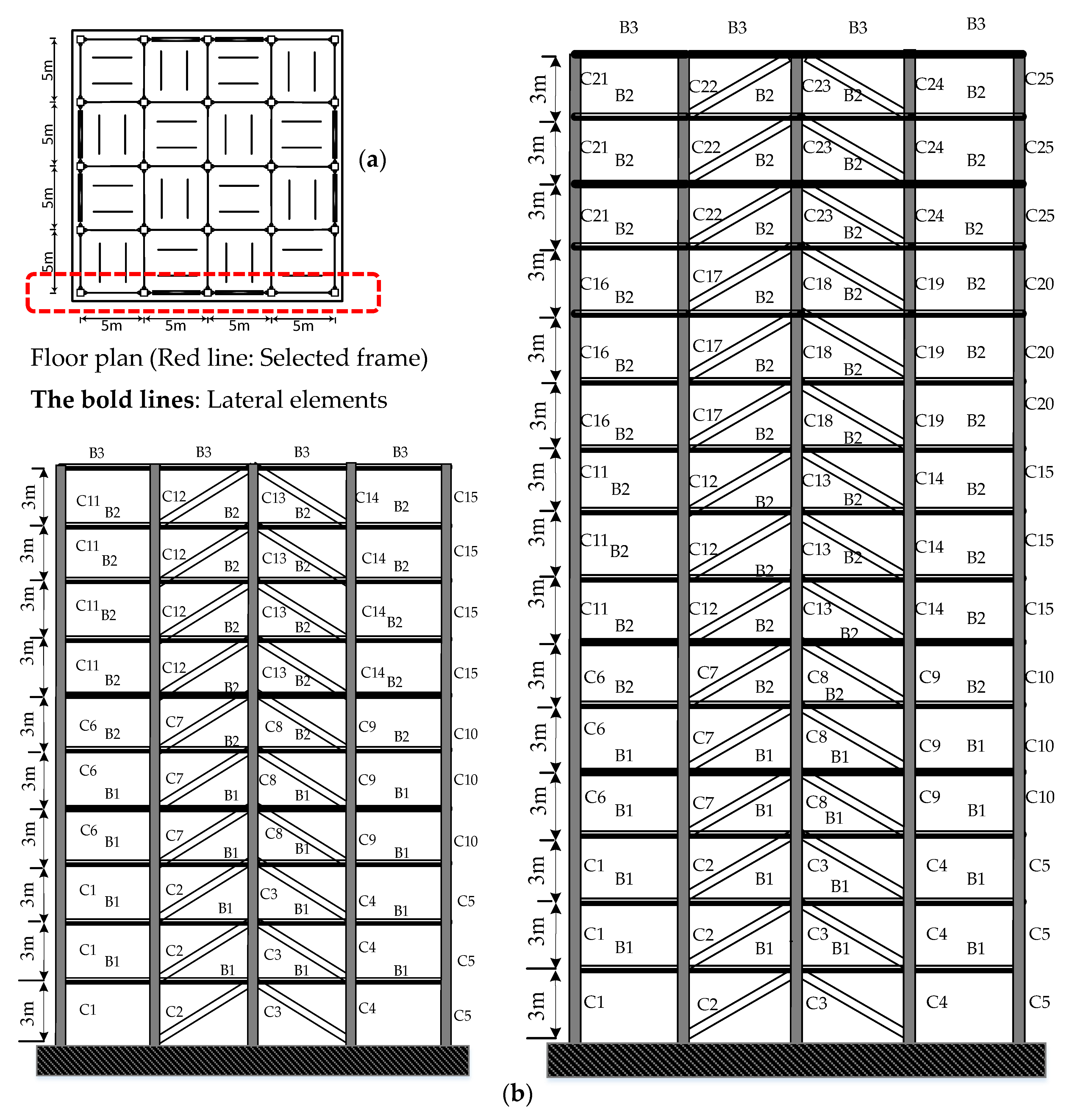
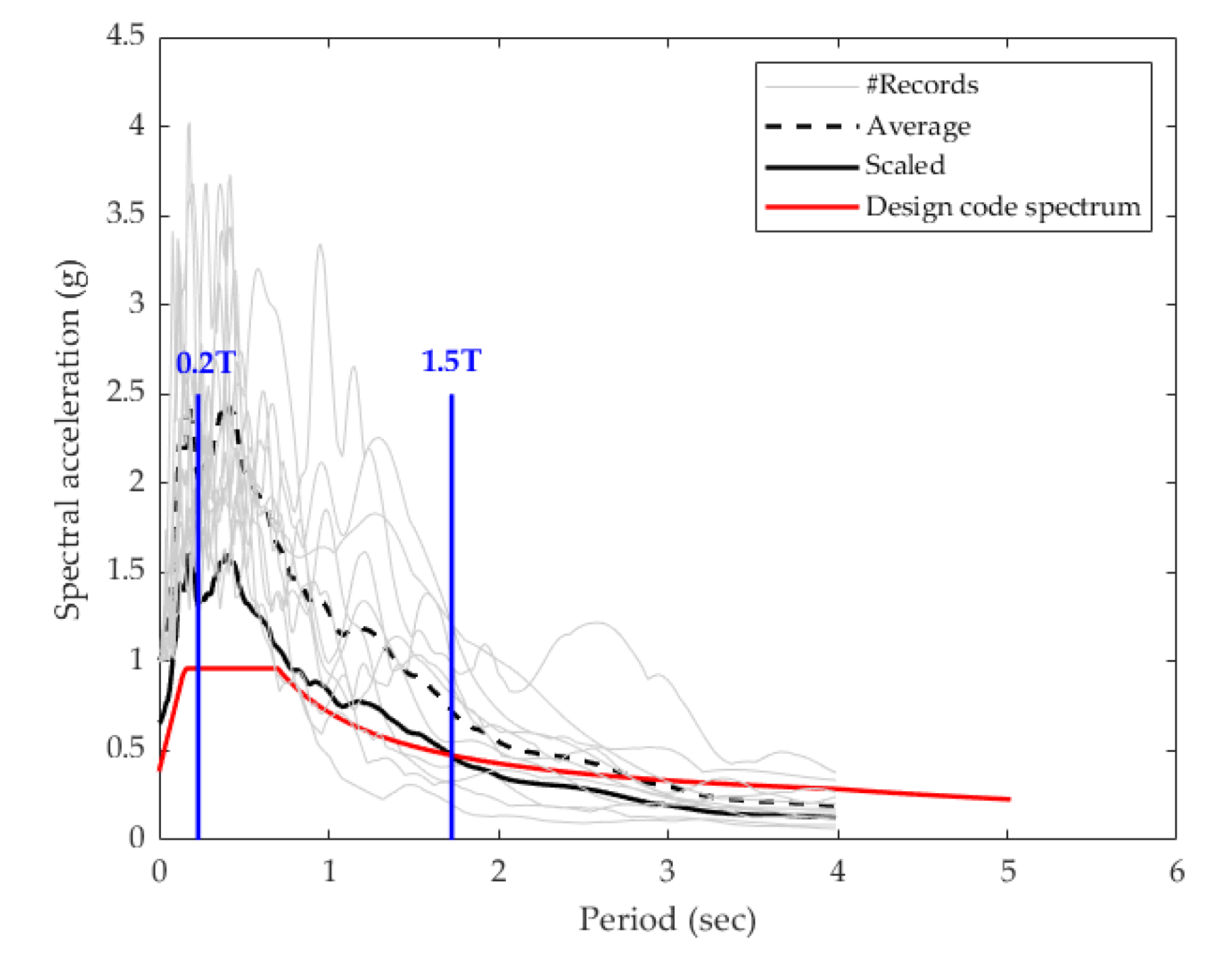
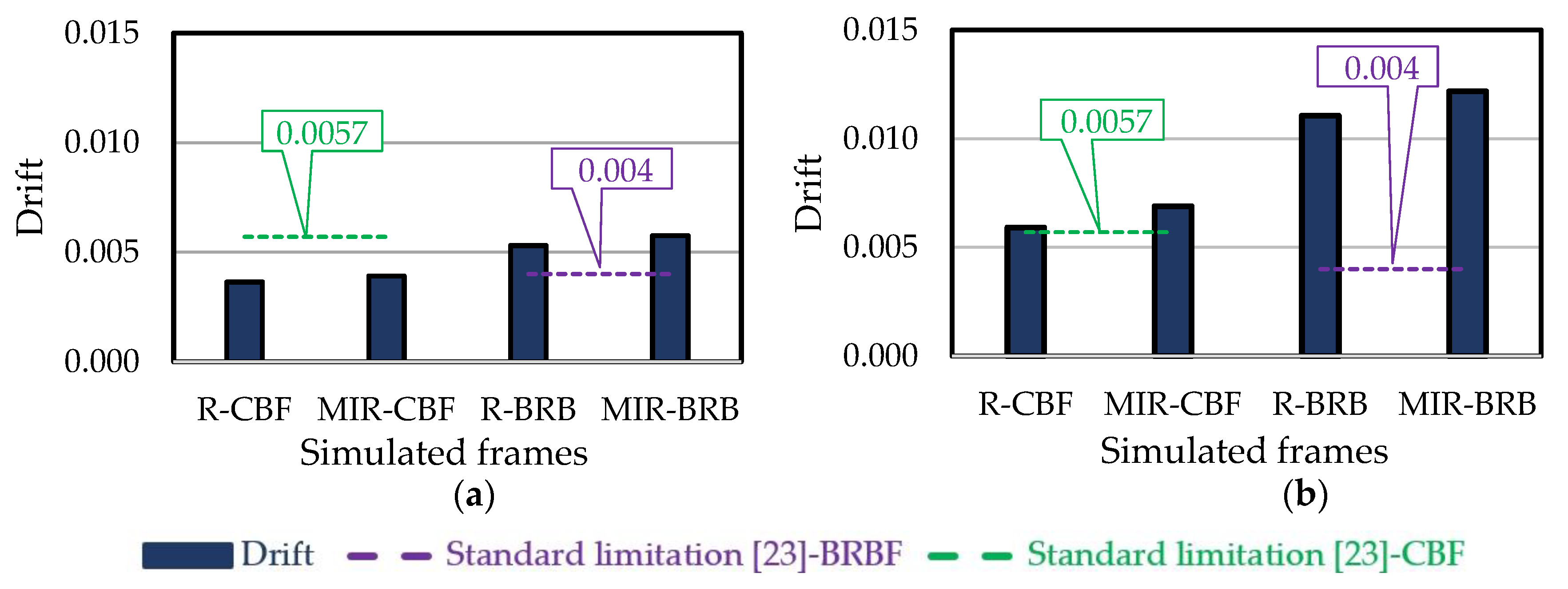
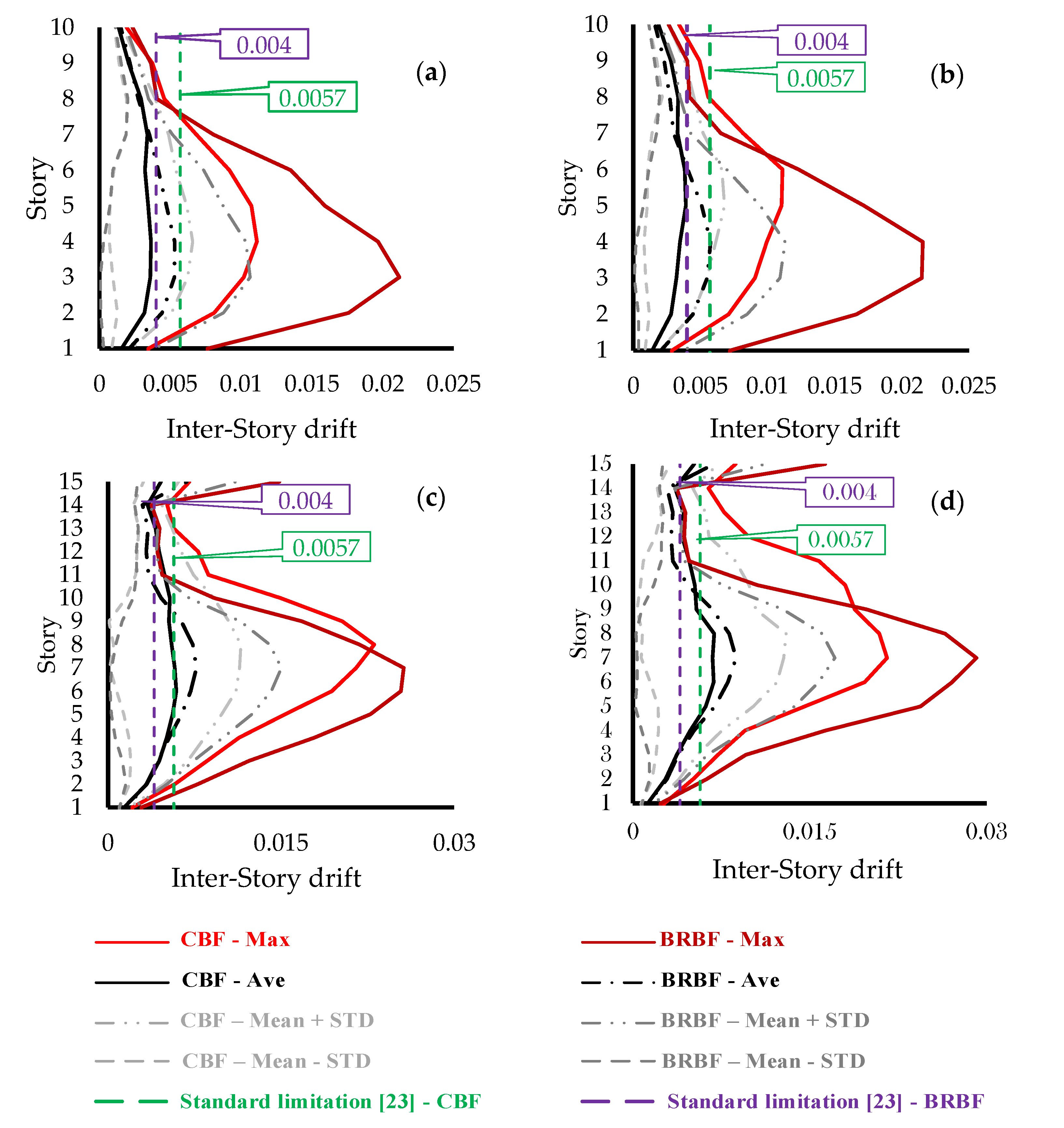
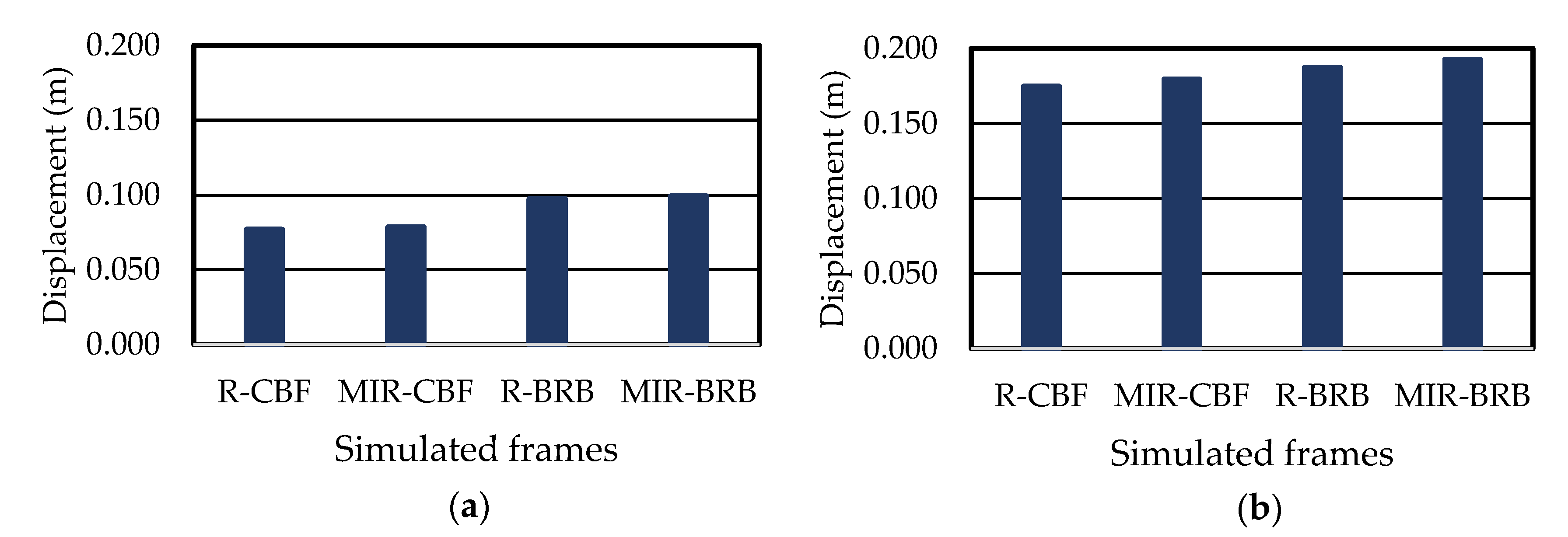
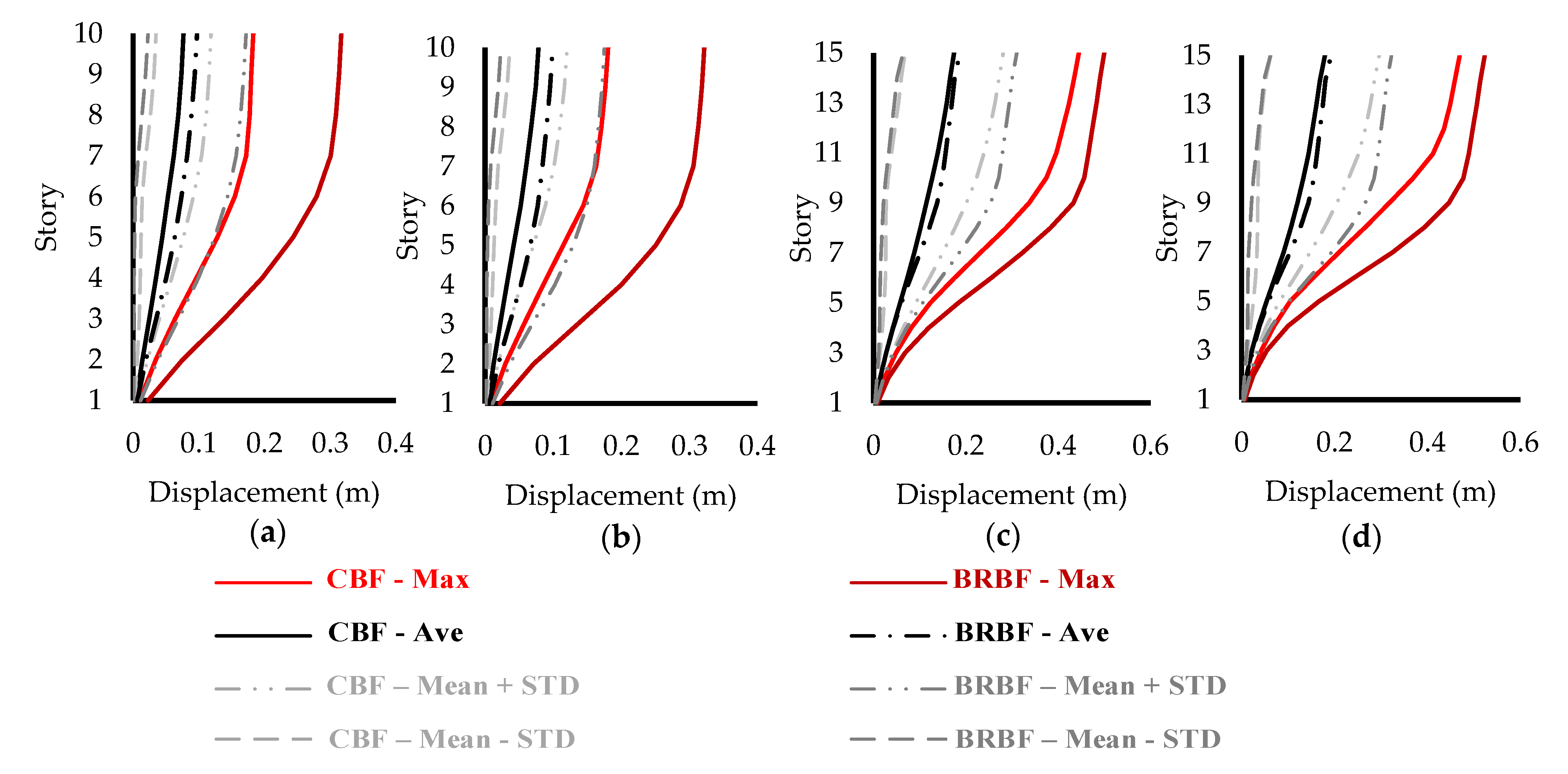


| Regular Frames | Mass Irregularity Frames | ||||||||
|---|---|---|---|---|---|---|---|---|---|
| [R-BRBF 1/R-CBF 2] | [MIR-BRBF 3/MIR-CBF 4] | ||||||||
| Column Sections (width × thickness) (mm) | Column Sections (width × thickness) (mm) | ||||||||
| C1 | C2 | C3 | C4 | C5 | C1 | C2 | C3 | C4 | C5 |
| 250 × 20 | 550 × 40 | 400 × 30 | 550 × 40 | 250 × 20 | 360 × 30 | 550 × 40 | 400 × 30 | 550 × 40 | 360 × 30 |
| C6 | C7 | C8 | C9 | C10 | C6 | C7 | C8 | C9 | C10 |
| 230 × 15 | 500 × 30 | 230 × 15 | 500 × 30 | 230 × 15 | 300 × 25 | 500 × 30 | 350 × 25 | 500 × 30 | 300 × 25 |
| C11 | C12 | C13 | C14 | C15 | C11 | C12 | C13 | C14 | C15 |
| 170 × 12 | 400 × 30 | 300 × 25 | 400 × 30 | 170 × 12 | 280 × 15 | 400 × 30 | 300 × 25 | 400 × 30 | 280 × 15 |
| Beam Sections * (mm) | Beam Sections * (mm) | ||||||||
| B1 | B2 | B3 | B1 | B2 | B3 | ||||
| IPE270 | IPE240 | IPE220 | IPE300 | IPE270 | IPE220 | ||||
| * Beam sections were chosen from European standard profiles. | 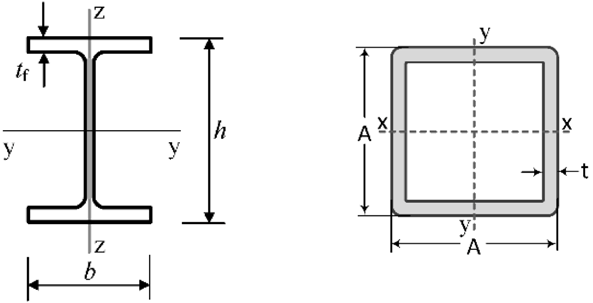 | ||||||||
| 1Regular-Buckling Resistant Braced Frame (R-BRBF) | |||||||||
| 2Regular-Concentric Braced Frame (R-CBF) | |||||||||
| 3Mass Irregularity-Buckling Resistant Braced Frame (MIR-BRBF) | |||||||||
| 4Mass Irregularity-Concentric Braced Frame (MIR-CBF) | |||||||||
| Regular Frames | Mass Irregularity Frames | ||||||||
|---|---|---|---|---|---|---|---|---|---|
| [R-BRBF 1/R-CBF 2] | [MIR-BRBF 3/MIR-CBF 4] | ||||||||
| Column Sections (width × thickness) (mm) | Column Sections (width × thickness) (mm) | ||||||||
| C1 | C2 | C3 | C4 | C5 | C1 | C2 | C3 | C4 | C5 |
| 400 × 30 | 600 × 40 | 400 × 30 | 600 × 40 | 400 × 30 | 400 × 30 | 700 × 60 | 400 × 30 | 700 × 60 | 400 × 30 |
| C6 | C7 | C8 | C9 | C10 | C6 | C7 | C8 | C9 | C10 |
| 360 × 30 | 550 × 40 | 360 × 30 | 550 × 40 | 360 × 30 | 360 × 30 | 550 × 40 | 360 × 30 | 550 × 40 | 360 × 30 |
| C11 | C12 | C13 | C14 | C15 | C11 | C12 | C13 | C14 | C15 |
| 280 × 15 | 500 × 30 | 280 × 15 | 500 × 30 | 280 × 15 | 280 × 15 | 500 × 30 | 280 × 15 | 500 × 30 | 280 × 15 |
| C16 | C17 | C18 | C19 | C20 | C16 | C17 | C18 | C19 | C20 |
| 230 × 15 | 450 × 25 | 230 × 15 | 450 × 25 | 230 × 15 | 230 × 15 | 450 × 25 | 230 × 15 | 450 × 25 | 230 × 15 |
| C21 | C22 | C23 | C24 | C25 | C21 | C22 | C23 | C24 | C25 |
| 174 × 12 | 400 × 20 | 174 × 12 | 400 × 20 | 174 × 12 | 174 × 12 | 400 × 20 | 174 × 12 | 400 × 20 | 174 × 12 |
| Beam Sections (mm) | Beam Sections (mm) | ||||||||
| B1 | B2 | B3 | B1 | B2 | B3 | ||||
| IPE300 | IPE270 | IPE240 | IPE300 | IPE270 | IPE240 | ||||
| Regular Buildings | |||
|---|---|---|---|
| 10-Story BRBF | 10-Story CBF | 15-Story BRBF | 15-Story CBF |
| 1.15 | 1.057 | 1.58 | 1.654 |
| Mass Irregularity Buildings | |||
| 10-Story BRBF | 10-Story CBF | 15-Story BRBF | 15-Story CBF |
| 1.106 | 1.083 | 1.497 | 1.507 |
| Record | Earthquake | Station | PGA | M | Distance (km) |
|---|---|---|---|---|---|
| #EQ1 | Big Bear-1992 | Desert Hot Spr | 0.22 | 6.4 | 39.5 |
| #EQ2 | Imperial valley-06-1979 | Delta | 0.35 | 6.5 | 33.7 |
| #EQ3 | Imperial Valley-1979 | Calexico Fire Station | 0.277 | 6.5 | 10.45 |
| #EQ4 | Kobe_Japan-1995 | Shin Osaka | 0.233 | 6.9 | 46 |
| #EQ5 | Kocaeli_Turkey-1999 | Duzce | 0.36 | 7.5 | 98.2 |
| #EQ6 | Landers-1992 | North Palm Springs | 0.075 | 7.2 | 36.15 |
| #EQ7 | Landers-1992 | Yermo Fire Station | 0.2445 | 7.3 | 86 |
| #EQ8 | Loma Prieta-1989 | Gilroy Array #3 | 0.559 | 6.9 | 31.4 |
| #EQ9 | Loma Prieta-1989 | Coyote Lake Dam (Downst) | 0.18 | 7.1 | 20.8 |
| #EQ10 | Imperial valley-06-1979 | El Centro Array #11 | 0.379 | 6.5 | 29.4 |
| #EQ11 | Superstition Hills-02-1987 | El Centro Imp. Co | 0.357 | 6.5 | 35.8 |
| #EQ12 | Superstition Hills-1987 | Poe Road | 0.45 | 6.5 | 11.2 |
| Type of Frames | Type of Response | ||||||||||||||
|---|---|---|---|---|---|---|---|---|---|---|---|---|---|---|---|
| Drift | Displacement (m) | Base Shear (kN) | Acceleration (m/s2) | ||||||||||||
| Frame | Value | Event | story | Frame | Value | Event | story | Frame | Value | Event | Frame | Value | Event | story | |
| 10-Story | R-CBF | 0.011 | Kocaeli | 4 | MIR-CBF | 0.181 | Kocaeli | 10 | R-CBF | 26,096 | Kocaeli | R-CBF | 7.665 | Gilroy | 10 |
| MIR-CBF | 0.011 | Kocaeli | 5 | R-CBF | 0.183 | Kocaeli | 10 | MIR-CBF | 26,752.2 | Kocaeli | MIR-CBF | 7.579 | Gilroy | 10 | |
| R-BRB | 0.022 | Kocaeli | 3 | R-BRB | 0.317 | Kocaeli | 10 | R-BRB | 28,709.1 | Kocaeli | R-BRB | 7.506 | Gilroy | 10 | |
| MIR-BRB | 0.022 | Kocaeli | 4 | MIR-BRB | 0.322 | Kocaeli | 10 | MIR-BRB | 29,331.2 | Kocaeli | MIR-BRB | 7.877 | Gilroy | 10 | |
| 15-Story | MIR-CBF | 0.022 | Kocaeli | 7 | R-CBF | 0.445 | Kocaeli | 15 | R-CBF | 10,862.1 | Shin-Osaka | R-CBF | 7.764 | Gilroy | 15 |
| R-CBF | 0.023 | Kocaeli | 7 | MIR-CBF | 0.469 | Kocaeli | 15 | MIR-CBF | 26,908.8 | El centro Array | MIR-CBF | 8.458 | Gilroy | 15 | |
| R-BRB | 0.026 | Kocaeli | 7 | R-BRB | 0.500 | Kocaeli | 15 | R-BRB | 32,406 | Centro Imp. Co | R-BRB | 8.748 | Gilroy | 15 | |
| MIR-BRB | 0.029 | Kocaeli | 7 | MIR-BRB | 0.523 | Kocaeli | 15 | MIR-BRB | 34,582.4 | Centro Imp. Co | MIR-BRB | 9.141 | Gilroy | 15 | |
Publisher’s Note: MDPI stays neutral with regard to jurisdictional claims in published maps and institutional affiliations. |
© 2020 by the authors. Licensee MDPI, Basel, Switzerland. This article is an open access article distributed under the terms and conditions of the Creative Commons Attribution (CC BY) license (http://creativecommons.org/licenses/by/4.0/).
Share and Cite
Karami, A.; Shahbazi, S.; Kioumarsi, M. A Study on the Effects of Vertical Mass Irregularity on Seismic Behavior of BRBFs and CBFs. Appl. Sci. 2020, 10, 8314. https://doi.org/10.3390/app10238314
Karami A, Shahbazi S, Kioumarsi M. A Study on the Effects of Vertical Mass Irregularity on Seismic Behavior of BRBFs and CBFs. Applied Sciences. 2020; 10(23):8314. https://doi.org/10.3390/app10238314
Chicago/Turabian StyleKarami, Armin, Shahrokh Shahbazi, and Mahdi Kioumarsi. 2020. "A Study on the Effects of Vertical Mass Irregularity on Seismic Behavior of BRBFs and CBFs" Applied Sciences 10, no. 23: 8314. https://doi.org/10.3390/app10238314






